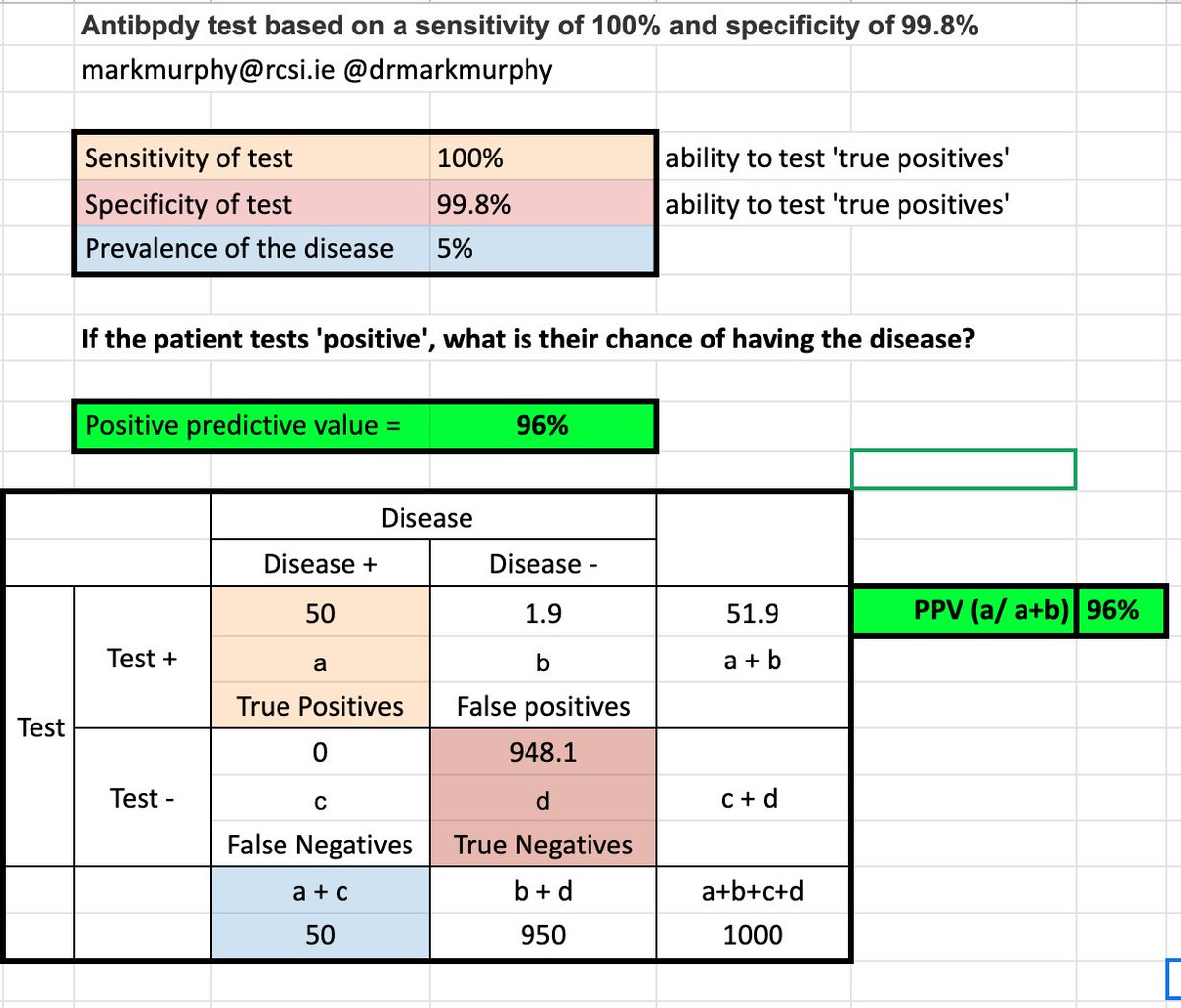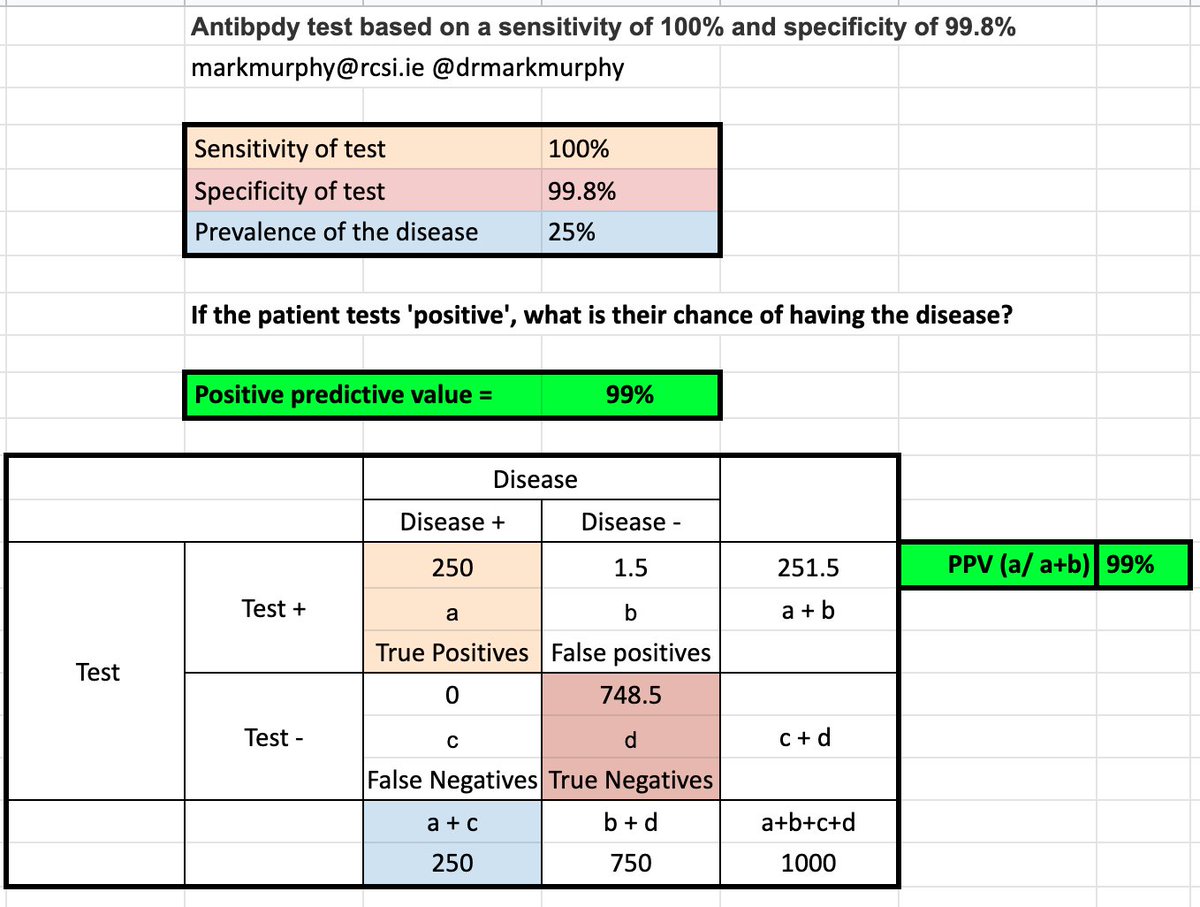A few points about the 2 common diagnostic #tests & #COVID19
 https://abs.twimg.com/emoji/v2/... draggable="false" alt="🔹" title="Small blue diamond" aria-label="Emoji: Small blue diamond">The nasal-swab test which looks for viral particles & an acute infection
https://abs.twimg.com/emoji/v2/... draggable="false" alt="🔹" title="Small blue diamond" aria-label="Emoji: Small blue diamond">The nasal-swab test which looks for viral particles & an acute infection
 https://abs.twimg.com/emoji/v2/... draggable="false" alt="🔸" title="Small orange diamond" aria-label="Emoji: Small orange diamond">The antibody test for a past-COVID19 infection
https://abs.twimg.com/emoji/v2/... draggable="false" alt="🔸" title="Small orange diamond" aria-label="Emoji: Small orange diamond">The antibody test for a past-COVID19 infection
We need to consider three things to determine how useful a & #39;diagnostic test& #39; is for a person
We need to consider three things to determine how useful a & #39;diagnostic test& #39; is for a person
(I stress a person and not population).
1/ The sensitivity of the test (ability of a test to pick up true positives e.g. the person actually has or had COVID19 and also has a positive test result).
1/ The sensitivity of the test (ability of a test to pick up true positives e.g. the person actually has or had COVID19 and also has a positive test result).
2/ The specificity of the test (ability of the test to pick up true negatives).
3/ The prevalence of the disease in the community.
All three impact what a & #39;positive result& #39; means for a person.
3/ The prevalence of the disease in the community.
All three impact what a & #39;positive result& #39; means for a person.
Let& #39;s consider these two diagnostic tests:
 https://abs.twimg.com/emoji/v2/... draggable="false" alt="🔹" title="Small blue diamond" aria-label="Emoji: Small blue diamond">The test for viral particles with a nasal swab (COVID-19 RT-PCR) test:
https://abs.twimg.com/emoji/v2/... draggable="false" alt="🔹" title="Small blue diamond" aria-label="Emoji: Small blue diamond">The test for viral particles with a nasal swab (COVID-19 RT-PCR) test:
(sens = 70%; spec = 95%)
 https://abs.twimg.com/emoji/v2/... draggable="false" alt="🔸" title="Small orange diamond" aria-label="Emoji: Small orange diamond">The new serology (antibody) test announced by Roche:
https://abs.twimg.com/emoji/v2/... draggable="false" alt="🔸" title="Small orange diamond" aria-label="Emoji: Small orange diamond">The new serology (antibody) test announced by Roche:
(sens = 100%; spec = 99.8%)
(sens = 70%; spec = 95%)
(sens = 100%; spec = 99.8%)
See the attached images. The sensitivity & specificity of the test is known (70% & 95%). The three models below, assume a prevalence of 20% and 50% and 90%.
- 20% prevalence (or 20% likelihood of acute COVID19 based on symptoms): A positive test would mean
the likelihood of COVID19 is 78% (=post-test likelihood of disease). The counter-point to this- with a 20% background prevalence- is that 22% of people who & #39;test positive& #39; do not have COVID19. That means that testing a lower prevalence group with a nasal swab- will falsely tell
over 1:5 people that they tested positive (when they don& #39;t have COVID19)- that could impact how they behave & expose themselves in the coming weeks/ months.
- 30% prevalence model: A positive test would mean the likelihood of COVID19 is 93% (=post-test likelihood of disease). The
- 30% prevalence model: A positive test would mean the likelihood of COVID19 is 93% (=post-test likelihood of disease). The
counter-point to this- with a 50% background prevalence- is that 7% of people who & #39;test positive& #39; do not have COVID19.
- 90% prevalence model: A positive test would mean the likelihood of COVID19 is 99% (=post-test likelihood of disease).
- 90% prevalence model: A positive test would mean the likelihood of COVID19 is 99% (=post-test likelihood of disease).
a)Serology (antibody test):
See the attached images. The sensitivity and specificity of the test is possibly known (100% & 99.8%). The two models below, assume a prevalence of 5% and 20%.
See the attached images. The sensitivity and specificity of the test is possibly known (100% & 99.8%). The two models below, assume a prevalence of 5% and 20%.
- 5% prevalence model: A positive test would mean the likelihood of past COVID19 is 96% (=post-test likelihood of disease). That means the 1:20 people will be told they had a past COVID19 infection, when they did not.
- 20% prevalence model: The positive predictive value is 99%
- 20% prevalence model: The positive predictive value is 99%
Like all tests, the importance of a & #39;positive& #39; finding varies by baseline prevalence and no test is 100% accurate.Phrases like & #39;100% accurate& #39; don& #39;t convey what& #39;s behind the test. Read the wonderful @drjessicawatson below for more information &numbers: https://www.bmj.com/content/369/bmj.m1808">https://www.bmj.com/content/3...

 Read on Twitter
Read on Twitter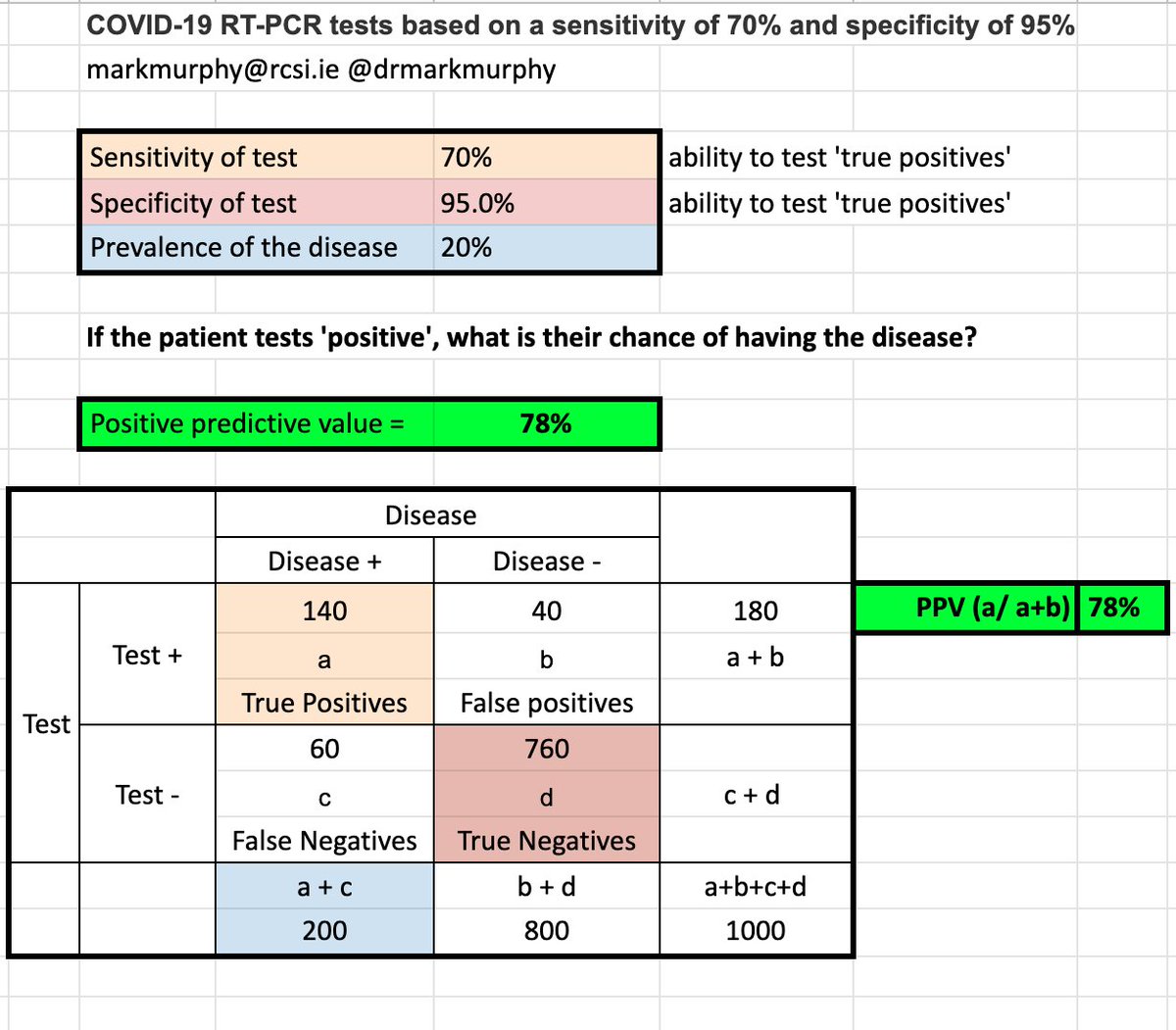 a) Viral swab test:See the attached images. The sensitivity & specificity of the test is known (70% & 95%). The three models below, assume a prevalence of 20% and 50% and 90%. - 20% prevalence (or 20% likelihood of acute COVID19 based on symptoms): A positive test would mean" title="https://abs.twimg.com/emoji/v2/... draggable="false" alt="🔹" title="Small blue diamond" aria-label="Emoji: Small blue diamond">a) Viral swab test:See the attached images. The sensitivity & specificity of the test is known (70% & 95%). The three models below, assume a prevalence of 20% and 50% and 90%. - 20% prevalence (or 20% likelihood of acute COVID19 based on symptoms): A positive test would mean">
a) Viral swab test:See the attached images. The sensitivity & specificity of the test is known (70% & 95%). The three models below, assume a prevalence of 20% and 50% and 90%. - 20% prevalence (or 20% likelihood of acute COVID19 based on symptoms): A positive test would mean" title="https://abs.twimg.com/emoji/v2/... draggable="false" alt="🔹" title="Small blue diamond" aria-label="Emoji: Small blue diamond">a) Viral swab test:See the attached images. The sensitivity & specificity of the test is known (70% & 95%). The three models below, assume a prevalence of 20% and 50% and 90%. - 20% prevalence (or 20% likelihood of acute COVID19 based on symptoms): A positive test would mean">
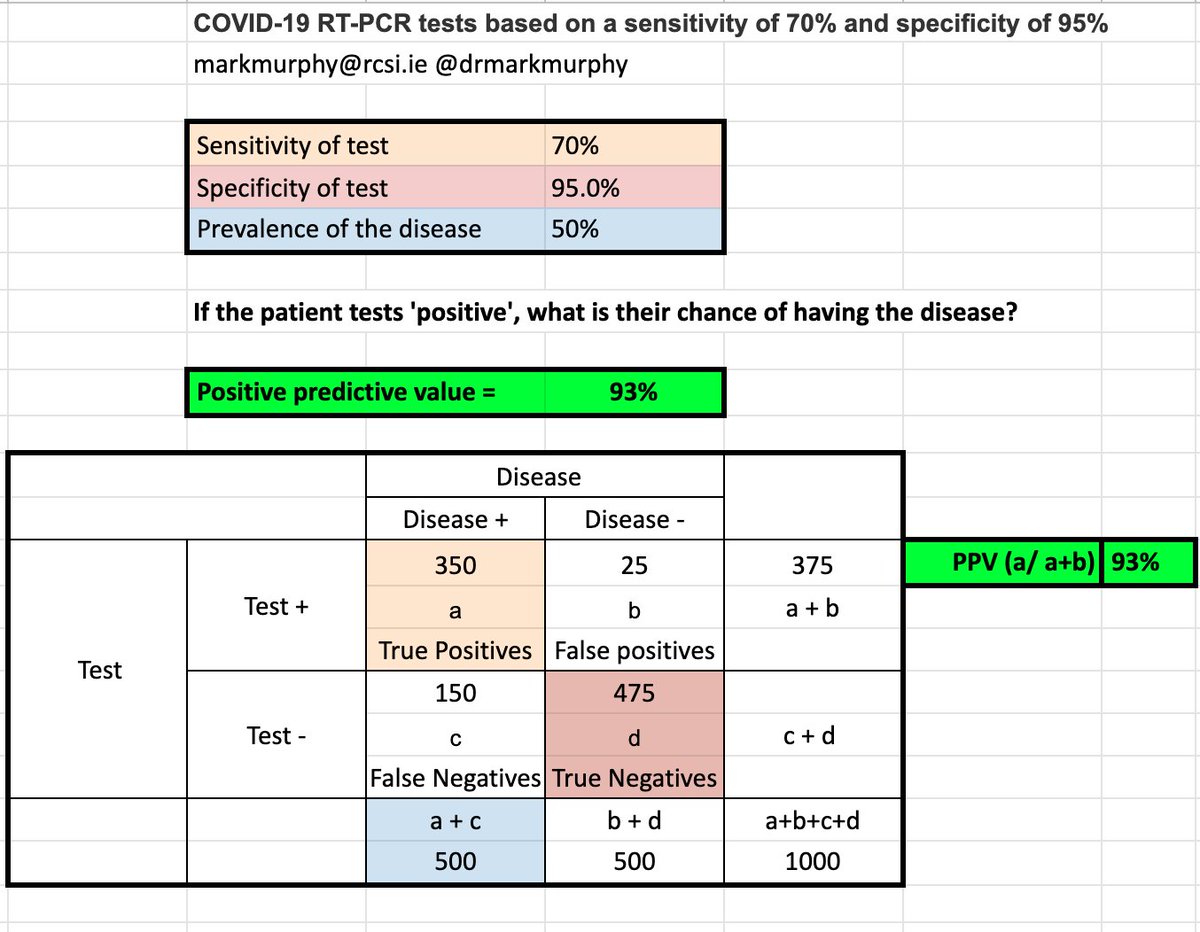 a) Viral swab test:See the attached images. The sensitivity & specificity of the test is known (70% & 95%). The three models below, assume a prevalence of 20% and 50% and 90%. - 20% prevalence (or 20% likelihood of acute COVID19 based on symptoms): A positive test would mean" title="https://abs.twimg.com/emoji/v2/... draggable="false" alt="🔹" title="Small blue diamond" aria-label="Emoji: Small blue diamond">a) Viral swab test:See the attached images. The sensitivity & specificity of the test is known (70% & 95%). The three models below, assume a prevalence of 20% and 50% and 90%. - 20% prevalence (or 20% likelihood of acute COVID19 based on symptoms): A positive test would mean">
a) Viral swab test:See the attached images. The sensitivity & specificity of the test is known (70% & 95%). The three models below, assume a prevalence of 20% and 50% and 90%. - 20% prevalence (or 20% likelihood of acute COVID19 based on symptoms): A positive test would mean" title="https://abs.twimg.com/emoji/v2/... draggable="false" alt="🔹" title="Small blue diamond" aria-label="Emoji: Small blue diamond">a) Viral swab test:See the attached images. The sensitivity & specificity of the test is known (70% & 95%). The three models below, assume a prevalence of 20% and 50% and 90%. - 20% prevalence (or 20% likelihood of acute COVID19 based on symptoms): A positive test would mean">
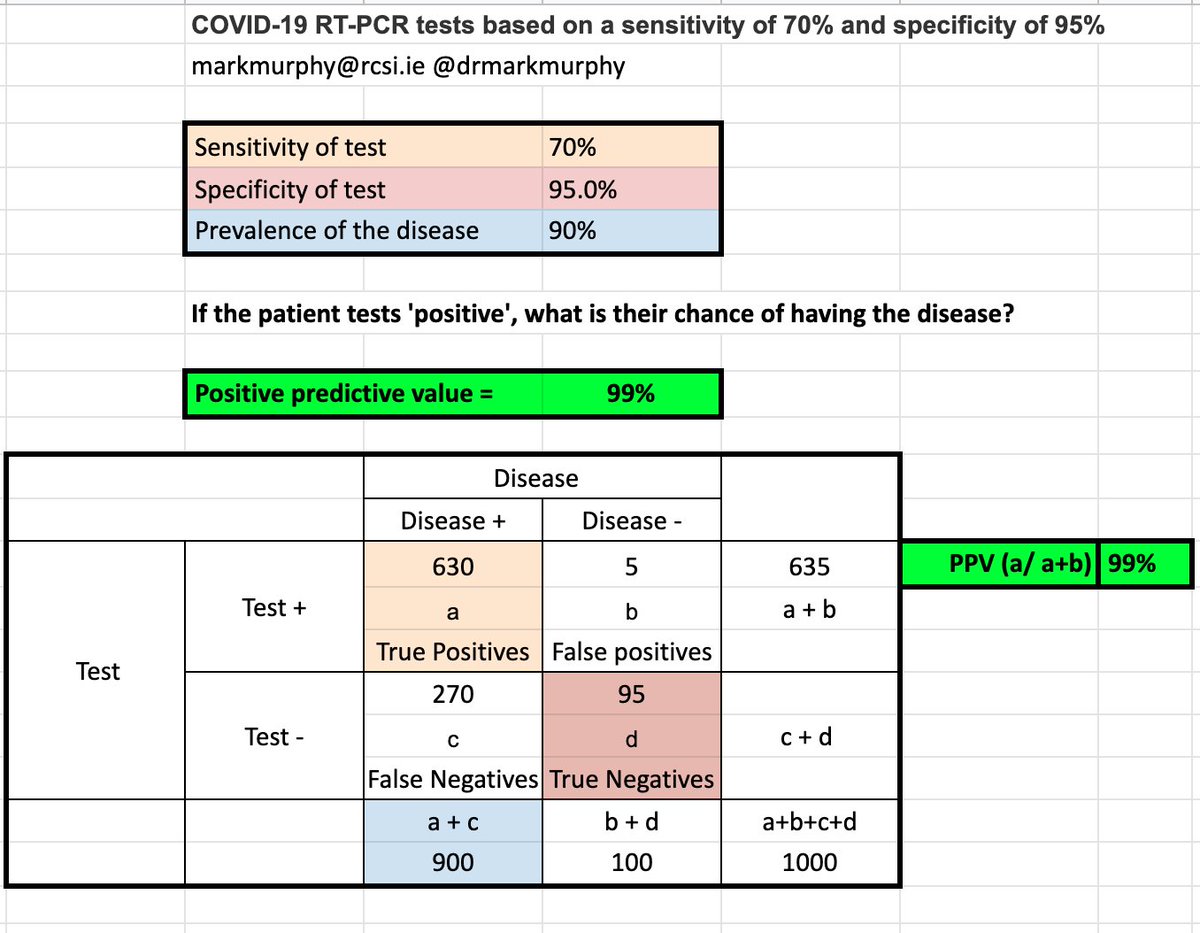 a) Viral swab test:See the attached images. The sensitivity & specificity of the test is known (70% & 95%). The three models below, assume a prevalence of 20% and 50% and 90%. - 20% prevalence (or 20% likelihood of acute COVID19 based on symptoms): A positive test would mean" title="https://abs.twimg.com/emoji/v2/... draggable="false" alt="🔹" title="Small blue diamond" aria-label="Emoji: Small blue diamond">a) Viral swab test:See the attached images. The sensitivity & specificity of the test is known (70% & 95%). The three models below, assume a prevalence of 20% and 50% and 90%. - 20% prevalence (or 20% likelihood of acute COVID19 based on symptoms): A positive test would mean">
a) Viral swab test:See the attached images. The sensitivity & specificity of the test is known (70% & 95%). The three models below, assume a prevalence of 20% and 50% and 90%. - 20% prevalence (or 20% likelihood of acute COVID19 based on symptoms): A positive test would mean" title="https://abs.twimg.com/emoji/v2/... draggable="false" alt="🔹" title="Small blue diamond" aria-label="Emoji: Small blue diamond">a) Viral swab test:See the attached images. The sensitivity & specificity of the test is known (70% & 95%). The three models below, assume a prevalence of 20% and 50% and 90%. - 20% prevalence (or 20% likelihood of acute COVID19 based on symptoms): A positive test would mean">
